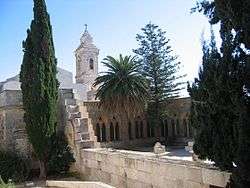Church of the Pater Noster
| Church of the Pater Noster | |
|---|---|
3007.jpg) | |
| Basic information | |
| Location | Jerusalem |
| Affiliation | Roman Catholic |
The Church of the Pater Noster, also known as the Sanctuary of the Eleona (French: Domaine de L'Eleona), is a partially reconstructed Roman Catholic church located on the Mount of Olives, north of the Tombs of the Prophets, in Jerusalem. It stands on the traditional site of Christ's teaching of the Lord's Prayer. (Luke 11:2-4). Today, the land on which the church stands formally belongs to France.
History
The modern church is built on the site of a fourth-century basilica designed by Constantine I to commemorate the Ascension of Jesus Christ. It was built under the direction of Constantine's mother Helena in the early 4th century, who named it the Church of the Disciples. The pilgrim Egeria was the first to refer to it as the church of the Eleona, meaning olive grove in the late 4th century. The church is mentioned by the Bordeaux pilgrim in the Itinerarium Burdigalense circa 333, and the historian Eusebius of Caesarea recounts that Constantine constructed a church over a cave on the Mount of Olives that had been linked with the Ascension.[1] The 2nd century Acts of John mention the existence of a cave on the Mount of Olives associated with the teachings of Jesus, but not specifically the Lord's Prayer. The church survived intact until it was destroyed by Persians in 614. The memory of Jesus' teaching remained associated with this site, and during the crusades it became exclusively associated with the teaching of the Lord's Prayer. Christian crusaders constructed a small oratory amid the ruins in 1106, and a full church was constructed in 1152 thanks to funds donated by the Bishop of Denmark, who is buried inside the church. The crusader era church was heavily damaged during the Siege of Jerusalem in 1187, eventually being abandoned and falling into ruin in 1345. In 1851 the remaining stones of the 4th-century church were sold for tombstones in the Valley of Jehoshaphat. The site was acquired by Princess Aurelia Bossi de la Tour d'Auvergne in the late 19th century and a search for the cave mentioned by early pilgrims began. In 1868 she built a cloister modeled on the Campo Santo at Pisa, Italy and founded a Carmelite convent in 1872. In 1910 the foundations over the cave were found partly beneath the cloister. The convent was moved nearby and reconstruction of the Byzantine church began in 1915. The church remains unfinished.

Design and layout
The 4th-century Byzantine church has been partially reconstructed and provides a good sense of what the original was like. The church's dimensions are the same as the original and the garden outside the three doors outlines the atrium area. The church is unroofed and has steps that lead into a grotto where some Christians believe that Jesus revealed to his disciples his prophecy of the destruction of Jerusalem and the second coming. Unfortunately the cave containing the grotto partially collapsed when it was discovered in 1910. It also cuts partly into a 1st-century tomb. Left of the church's south door is a baptistery paved with mosaic. The cloister is of European style and contains plaques that bear the Lord's Prayer in over 100 different languages.[2] A road to the right of the convent leads to the Russian Church of the Ascension and Byzantine tomb chapels where some Armenian mosaics are preserved in a small museum.
Location
The church is located in the At-Tur district of Jerusalem which has a population of about 18,000 mostly Muslim Arabs, with a small Christian minority.
Gallery
-

Side View -
Close Up of Unfinished Wall -
French Flag at the Church -
View from the Colonnade -
The Lord's Prayer in many languages -
The Lord's Prayer in Biblical Greek -

The Lord's Prayer in Latin -
The Lord's Prayer in French -
The Lord's Prayer in Korean -
Sign in French and English -

The Lord's Prayer in Esperanto
References
- Jerome Murphy-O'Connor, Oxford Archaeological Guides: The Holy Land (Oxford, 1998), 125-26.
- Kay Prag, Blue Guide to Israel and the Palestinian Territories (Black and Norton, 2002), 230-31.
- Daniel Jacobs, Mini Rough Guide to Jerusalem (Rough Guides, 1999), 105-06.
External links
| Wikimedia Commons has media related to Church of the Pater Noster. |
Coordinates: 31°46′41.08″N 35°14′42.69″E / 31.7780778°N 35.2451917°E